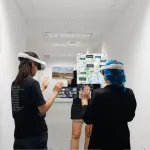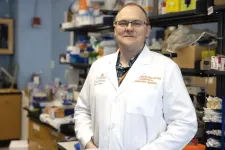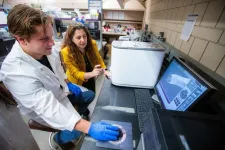(Press-News.org) Virtual, augmented and other extended reality technologies present the possibility to transform health care, education, entertainment, communication and more.
And that transformation is close.
Headsets and haptic gloves could connect doctors and patients thousands of miles apart in a virtual hospital. Sensors could monitor someone's health or help teachers know if their students are paying attention. Scanners could allow objects from a person's home to appear in their favorite video game. Glasses could help people with visual impairments navigate the world around them. Extended reality (XR) technologies have the potential to complement or replace smartphones, laptops, tablets and other devices for many tasks.
Carnegie Mellon University has launched its Extended Reality Technology Center (XRTC) to bring together researchers, industry and consumers to maximize the potential of emerging developments in the field. The XRTC will drive the development of extended reality technologies, create a curriculum to train the next generation of XR talent, and encourage consumers to participate in its design and ultimately use the new tools.
"XR technologies will allow us to mix the digital world and the real world in ways that will improve how we work, play, learn, connect, and care for ourselves and others," said Fernando De La Torre, a co-director of the XRTC and an associate research professor in the Robotics Institute. "This is happening now. The technology is not yet mature, but the breakthrough is going to happen in the next five to 10 years, and CMU will be there when it happens."
Extended reality technologies are a natural next step in the evolution of computing. From large mainframes that took up entire rooms through the advent of desktop computers to the internet and smartphones, computing has become more personal, more connected and a larger part of people's lives. XR technologies take it a step further.
The XRTC will be led by co-directors De La Torre, Kris Kitani and David Lindlbauer, all faculty in the School of Computer Science (SCS). The center will unite researchers from across the university including from elsewhere in SCS and in the College of Engineering, Heinz College of Information Systems and Public Policy, College of Fine Arts, Dietrich College of Humanities and Social Sciences, CMU Libraries, and Entertainment Technology Center. The XRTC's work will be based at the new Robotics Innovation Center at Hazelwood Green.
"CMU has dozens of faculty and hundreds of students pushing boundaries in all the areas needed for extended reality technologies to be successful. It's unlikely another university in the United States or in the world has this many people working on this technology," said Lindlbauer, an assistant professor in the Human-Computer Interaction Institute. "We have the expertise. We just needed to bring this expertise together, and the XRTC does that."
The XRTC will launch with founding sponsors PNC and Fujitsu, companies that see XR technologies as transformative to their businesses and customer interactions.
PNC is a longtime partner of CMU. It previously invested in the PNC Center for Financial Services Innovation to capitalize on new technologies and the effectiveness of data to advance the functionality of banks and the services they offer customers. Its investment in the new XRTC is the latest demonstration of its commitment to enhancing innovative educational resources at CMU.
"Virtual reality has so many potential applications and is such an exciting space for those of us at PNC interested in the 'art of the possible,'" said Michael Degnan, head of enterprise innovation at PNC. "As part of our ongoing efforts to work collaboratively with CMU to advance our headquarters city of Pittsburgh as a center of technological innovation, we see this investment in the XRTC as the establishment of a new, regional space for discovery that will help many."
Fujitsu and CMU have collaborated on projects to use social digital twin technology to help create safer, more sustainable cities in the future and achieve breakthroughs in dynamic 3D structure representation that could be used for better simulation analysis and avatars. The Japanese company aims to use XR technologies to enhance working across physical and digital environments.
"Fujitsu has been thinking about how to utilize digital space for people to work more effectively. While keeping up overall productivity, the individual's engagement level should be taken care of as well in the digital workplace. We're excited about joining the XRTC community to explore technologies and partnerships toward this vision," said Naoki Matsuoka, a project director in Fujitsu Research's Converging Technologies Laboratory.
CMU is world-renowned for its innovations in the technologies driving the development of XR — mobile computing, chipsets, wireless broadband, computer vision, machine learning and user interfaces. The XRTC will focus its work in three areas: research to tackle emerging topics in XR; education to develop a new curriculum at the undergraduate, graduate and executive levels; and community to bring new technology to the public's attention, allowing for participation in its design and encouraging adoption.
The center will host an annual symposium to share the latest research and development in XR from academia and industry, and organize demo days, museum exhibitions and outreach workshops. It held its first XRTC Symposium on Nov. 9 at CMU, where researchers showcased the latest in XR technologies and led a wide-ranging discussion about the future of VR, augmented reality and other related fields.
"The XRTC Symposium was a great opportunity to see the kind of XR work already happening at CMU and to demonstrate that work to potential sponsors and future collaborators," said Kitani, an associate research professor in the Robotics Institute. "We've only recently launched and the excitement is already building."
Learn more about the XRTC, including how to become a sponsor, on the center's website.
END
Carnegie Mellon University's XRTC will drive research into VR, AR innovations
2023-11-28
ELSE PRESS RELEASES FROM THIS DATE:
UTHealth Houston School of Dentistry researcher awarded $2 million grant by NIH to study pharmacotoxicity of areca nut
2023-11-28
A five-year, $2 million grant to study the pharmacological effects of the areca nut, commonly known as the betel nut, was awarded to a UTHealth Houston researcher by the National Institute on Drug Abuse, part of the National Institutes of Health (NIH).
The study, led by Alan Myers, PharmD, PhD, associate professor of pharmacology with UTHealth Houston School of Dentistry, will investigate how chemicals in the areca nut are metabolized in the body’s organs, particularly in the liver, and how that process is disrupted by alcohol or menthol.
“On the global level, areca nut chewing has been around since antiquity, but still poses a major public health ...
Heart over head? Stages of the heart’s cycle affect neural responses
2023-11-28
Optimal windows exist for action and perception during the 0.8 seconds of a heartbeat, according to research published November 28th in the open access journal PLOS Biology. The sequence of contraction and relaxation is linked to changes in the motor system and its ability to respond to stimulation, and this could have implications for treatments for depression and stroke that excite nerve cells.
The ways in which we perceive and engage with the world are influenced by internal bodily processes such as heartbeats, respiration and digestion. Cardiac activity can influence auditory and ...
NASA’s Fermi Mission nets 300 gamma-ray pulsars … and counting
2023-11-28
A new catalog produced by a French-led international team of astronomers shows that NASA’s Fermi Gamma-ray Space Telescope has discovered 294 gamma-ray-emitting pulsars, while another 34 suspects await confirmation. This is 27 times the number known before the mission launched in 2008.
“Pulsars touch on a wide range of astrophysics research, from cosmic rays and stellar evolution to the search for gravitational waves and dark matter,” said study coordinator David Smith, research director at the Bordeaux Astrophysics Laboratory in Gironde, France, which is part of CNRS (the ...
Study reveals hidden immune defense against cancer
2023-11-28
FINDINGS
Researchers at the UCLA Jonsson Comprehensive Cancer Center have found certain immune cells can still fight cancer even when the cancer cells lack an important protein that the immune system relies on to help track down cancer cells.
The team discovered the absence of the crucial protein B2M seems to activate an alternative immune response involving natural killer (NK) cells and CD4+ T cells in both animal studies and patient tumor biopsies, indicating a potential backup mechanism in the immune system to recognize and attack cancer cells.
BACKGROUND
Immunotherapies, such as immune ...
Annals of Family Medicine: papers explore how technology is changing medical practice and how doctors are adapting
2023-11-28
Providence, R.I. – From the ability to conduct clinical visits online to utilizing artificial intelligence to effectively diagnose patients, technology has changed how all doctors practice medicine. One published paper in the November/December issue of Annals of Family Medicine explains how AI-driven technology presents new opportunities for more effective patient care while a second paper describes the interplay between fulfillment of basic psychological needs at work and technology use in maintaining clinician well-being.
In ...
Researchers advance 'placenta-on-a-chip' with sensing, imaging technology
2023-11-28
AMES, Iowa – A research poster dated Dec. 9, 2015, hangs just outside Nicole Hashemi’s Iowa State University laboratory. It introduces a major project for Hashemi and her research group. And it’s evidence that scientific persistence sometimes equals scientific advancement.
Hashemi, an associate professor of mechanical engineering, and her students have been working all these years to develop a “placenta-on-a-chip.” In this case that’s a thin, rectangular, clear, polymer block with two tiny microchannels – just millionths of ...
How neurotransmitters work together to detect and discriminate odors
2023-11-28
A longstanding hypothesis in neurobiology was that a single neuron releases a single type of neurotransmitter, a molecule used by neurons to communicate with one another. In recent decades, several neurons have been found to release more than one neurotransmitter. This phenomenon called co-transmission is increasingly gaining recognition as a powerful and versatile molecular mechanism useful for the dynamic regulation of diverse neural circuits. However, precisely how co-transmission affects the firing of ...
ChargeX Consortium recommends common EV charging station error codes
2023-11-28
New shared language will facilitate faster service, improve EV user experience
The National Charging Experience Consortium (ChargeX) has released a report that recommends 26 common electric vehicle (EV) charging error codes to enable faster error reporting, diagnostics and resolution within the EV charging industry. Ultimately, the codes would improve the U.S. charging experience.
The ChargeX Consortium is a collaboration between U.S. Department of Energy national laboratories, EV charging industry experts, consumer advocates and other stakeholders.
The Recommendations for Minimum Required Error Codes report aims to reduce confusion between charger manufacturers, EV manufacturers and ...
Ending the HIV epidemic may require addressing “everyday” discrimination
2023-11-28
Latino sexual minority men who experience racial, ethnic and sexual prejudice are more likely to delay HIV testing, complicating efforts to end the more than 40-year epidemic, according to a new Rutgers study.
“Total HIV infection rates in the United States are stabilizing, which is good news,” said Gabriel Robles, an assistant professor at the Rutgers School of Social Work and coauthor of the paper published in the journal AIDS Education and Prevention. “What’s bad is that the trend for some subgroups, including some Latino/x sexual minority men, is going in the opposite direction. Our study offers ...
Anonymous $10 million gift to Henry Ford Health establishes lung cancer tissue repository, bolsters research
2023-11-28
As Lung Cancer Awareness Month comes to a close, Henry Ford Health is proud to announce it has received an anonymous gift of $10 million, which is poised to significantly advance lung cancer research at Henry Ford Cancer.
This transformative gift has enabled Henry Ford to establish a new lung cancer tissue biorepository, which is a facility that catalogs and stores biological samples for research. These samples – in this case, lung cancer tissue – are crucial for scientists who are studying ...





